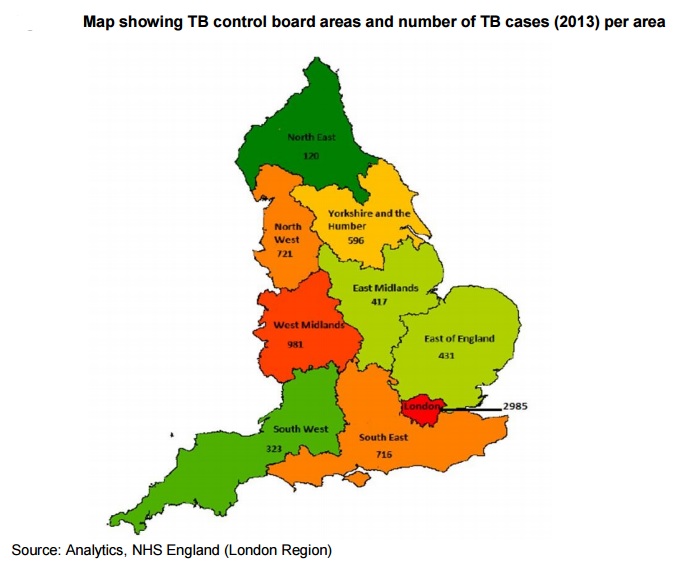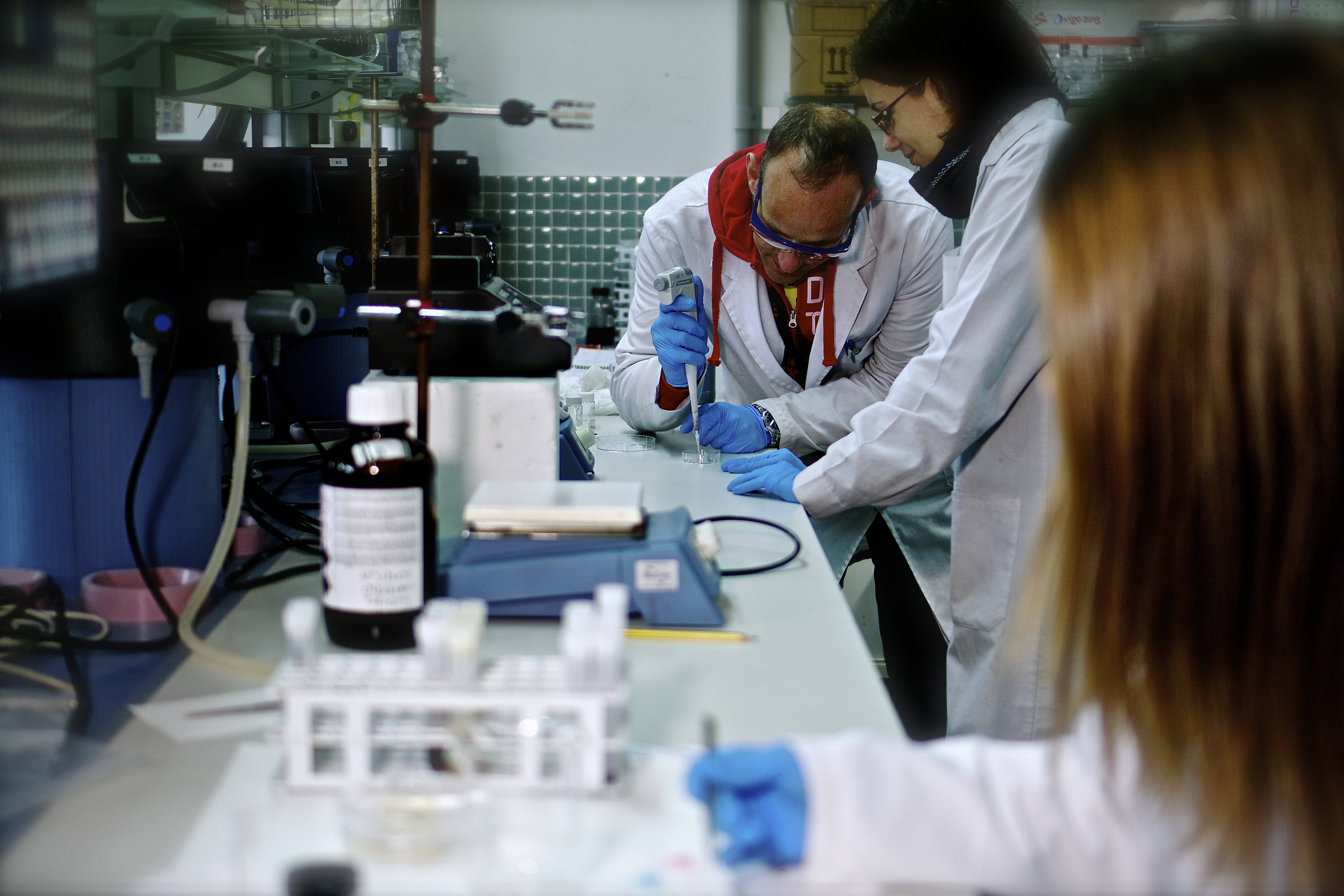England has the second highest tuberculosis (TB) rate in Western Europe, and a rate that is more than four times as high as in the US. Why is this seemingly Dickensian disease making a comeback in England today? And what is being done to tackle it?

Image by NIAID via Creative Commons
The TB capital of Western Europe
Figures show that TB cases are centred on large urban centres; Manchester, Birmingham and Coventry to name just three. However London accounts for almost 50% of all cases of TB reported in England. A third of London boroughs are classed as ‘high incidence’ by the World Health Organisation (WHO), placing them in the same band as countries like Iraq and Rwanda, with more than 40 confirmed cases per 100,000 people per day.
In 2013 there were 3,500 new cases of TB diagnosed in the capital. Healthcare professionals stress the importance of early diagnosis and treatment as being a key strategy to eradicating the disease.

Image from the Collaborative TB strategy for England 2015-2020
Stigmatisation is a real issue
TB is strongly associated with poverty and research has suggested that many people do not seek treatment for the disease because they are embarrassed about the potential repercussions of having to tell family members, support workers or employers. This not only poses a risk to the infected person, but significantly increases the chances of passing the infection on to others.
Similarly, statistics show that cases of TB are particularly prevalent among homeless populations and other vulnerable minority groups. Delays in seeking treatment, already-reduced immunity, pre-existing strains of the disease which can reoccur, and overcrowded shelters can all contribute to spreading the disease, which is caught through prolonged contact with an infected person (the bacteria is spread through airborne droplets).
Another barrier to effective treatment is misdiagnosis by general practitioners. As a result there has been a conscious effort in London in particular to educate general practitioners and other primary healthcare workers on possible symptoms in the hope that it will help increase rates of diagnosis and treatment, and reduce the number of new cases.
A public health emergency?
However, the rise of antibiotic and drug resistant strains of the disease is making treatment of TB even more difficult. A full course of treatment of non-drug resistant TB bacteria can take up to two years in some cases. If the strain is drug resistant, patients can be taking as many as 9 different drugs a day, many of which have severe side effects and can be life-limiting in themselves.
Doctors have suggested that the rise of these drug resistant strains is not being taken seriously by Public Health England, or other associated bodies and that drug resistant TB should be considered as a public health emergency. In 2014 the LGA produced guidance on the public health role which should be taken on by local authorities to tackle TB locally within communities.

Image by Rede Galega de Biomateriais via Creative Commons
Updated guidance and treatment programmes
In early 2016, the National Institute for Health and Care Excellence (NICE) published updated guidance on TB, with a particularly strong focus on: early treatment; targeting vulnerable groups; and improving education and awareness of the disease for patients and GPs on how to spot symptoms.
Prior to this, in 2015, Public Health England produced a collaborative strategy, in partnership with NHS England, to tackle TB in England. The strategy looks at how health boards, local authorities and national bodies can cooperate to achieve national outcomes on TB diagnosis, treatment and eventual eradication. The report considers the creation of nine regional TB control boards, who would work alongside national bodies to achieve these national objectives. London-specific objectives and strategies were published in October 2015.
Practical support for sufferers in communities
Find & Treat provides screening, advice and practical assistance to TB services and allied health and social care services in London. In partnership with Groundswell (a charity supporting homeless people), the team behind Find & Treat also recruit, train and support former TB patients who have experienced homelessness to work as peer advocates in their TB awareness team.
The Mobile X-ray Unit (MXU) now screens almost 10,000 socially vulnerable people at high risk of TB annually. The screening service operates in every London borough, and is regularly called to support the control of TB outbreaks nationally. University College London Hospitals (UCLH) host the service on behalf of NHS London, and are close to rolling out the Find & Treat initiative nationally (as recommended by NICE). Additionally in London there are two designated ‘hub’ hospitals, in the north and the south of the city with designated teams of TB specialists.
To further increase the profile of TB, prevention and treatment, actress Emma Thompson has been appointed as the Mayor of London’s TB Ambassador. This follows her son’s diagnosis with TB in 2011. Since her appointment she has been a very public face of TB awareness, regularly attending clinics and health drives to encourage people to get tested for the disease.
[youtube https://www.youtube.com/watch?v=Izi6I0zIYRw?rel=0&w=560&h=315]
As the statistics have shown, TB rates are frighteningly high in some areas of the UK, and particularly in London. It is hoped that increased guidance and public awareness will help stop the increase of cases and avoid the potential public health epidemic which could arise in London as the population grows and pressure on NHS services intensifies. There is added incentive to curb this spread as the rise of antibiotic resistant strains becomes more prevalent.
Vaccination programmes, effective treatment centres and early intervention community initiatives, as well as investment in research and development for new drugs to treat the disease effectively, will be key to ensuring positive outcomes for all those affected by, or at risk of, TB in the UK.
Follow us on Twitter to see what developments in public and social policy are interesting our research team.
Further blog posts from The Knowledge Exchange on health:
- Health Champions – “unlocking the power of communities”
- Public health in Scotland … problems and solutions
- How is health and social care integration being achieved in England?
- Child obesity – public health or child protection issue?
- The way forward for mental health services for children and young people
Share
Related Posts
By Donna Gardiner While free school meals (FSM) have been available in England on a means-tested basis since 1944, recent years have seen a renewed focus upon the potential benefits of providing free school meals to all school-aged children. Currently, ....
Today sees the start of Community Garden Week 2023. Across the UK, communities will be celebrating the many and varied types of community gardens, from children’s and neighbourhood gardens to therapy gardens and allotments. The benefits of community gardens are ....
By Hollie Wilson At the start of 2020, an independent review was published setting out what needed to be done to bring about changes to the care system for children and young people in Scotland. At the heart of the ....
The “No Wrong Door” (NWD) programme means exactly that – there is no wrong door to turn to for young people seeking support. NWD works on several core principles, which include working with young people’s birth family or guardians, allowing ....
